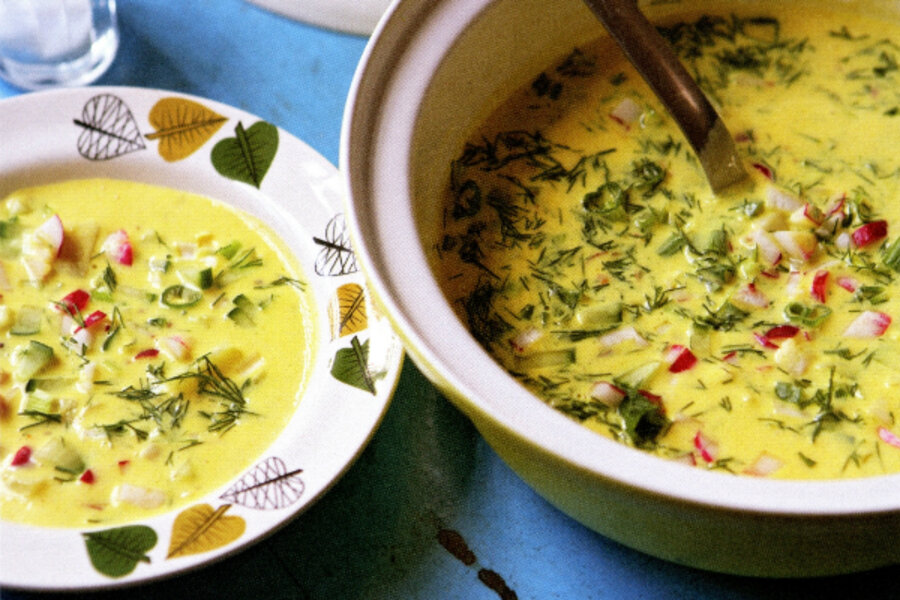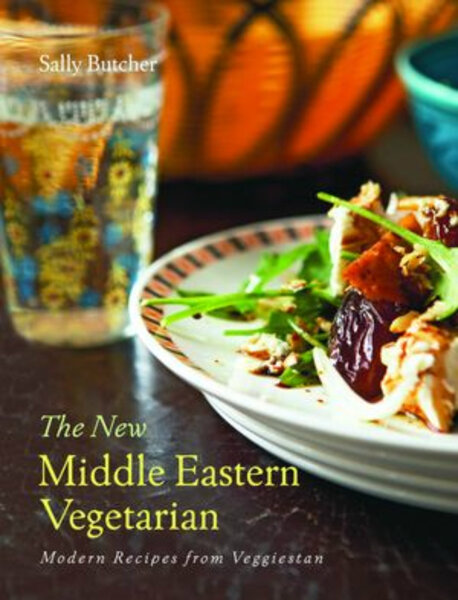Cookbook review: The New Middle Eastern Vegetarian by Sally Butcher
Loading...
While I was living in a town in eastern Kazakhstan, my next-door neighbor would invite me over to chat in her small, mostly sky-blue tiled Soviet-styled kitchen as she chopped and pounded and scraped and sloshed together all manner of exotic ingredients.
Whatever meal she was preparing would generally last her the week. Her wizened hands effortlessly moved from one task to the next as I sat there using up my limited Russian vocabulary, asking her questions and trying to follow along as she described what she was doing.
Her summer specialty was a Russian chilled dill soup, perfect for Kazakhstan’s sweltering summers, made from kefir (fermented mare's milk), cucumbers, and radishes. It was one of the few dishes she made that was meat-free, and I felt fortunate to have been introduced to it through this neighbor. Though she thought it was strange that I was a vegetarian, she was my guide on nonmeat foods to try.
When I saw that The New Middle Eastern Vegetarian: Modern Recipes from Veggiestan by Sally Butcher had a version of the Russian inspired shorba (Arabic for soup) I was both reminded of my neighbor guide, and eager to dive in on recipes from an area of the world, such as Kazakhstan, that I hadn’t previously considered veggie friendly. In fact, I learned, despite the traditional meat on kabobs, meat is used mostly for flavor or for special guests across the Middle East.
Butcher is the London-based owner of Persepolis, a Persian deli, which she runs with her Iranian husband. This is her second cookbook. Her first, “Persia in Peckham” (2008), drew wide acclaim. In "The New Middle Eastern Vegetarian," Butcher quickly shows her love for Middle Eastern flavors from Uzbekistan to Turkey to Iran. Leafing through the book, I was transported across the region with stories, fun facts, and recipes making use of rose petals, saffron, and tumeric.
Reading this book was like sitting down with a good, well traveled foodie friend – and a funny one at that. Through her frank, spunky pages, it’s easy to picture how she interacts with her deli customers. An entertaining element of Butcher's cookbook are her side notes, including “beguiling tales of how the eggplant got it’s hat” (hint: it’s in his looks). Yes, you read that right.
As for kefir, she writes: “Mmm. The original probiotic, if you like. It evolved as the famous horsemen of the region galloped the steppes: (mare's) milk, which they carried in saddle bags, would slowly ferment, forming a not unpleasant but entirely different drink. To this day kefir is a popular drink in places such as Uzbekistan and Kazakhstan. In the West it is more often the bacteria itself for which we use the term. You can buy it as grains or already developed (when it looks like something that Fungus the Bodyeman might have dreamed up): it is self-propagating (my, how it grows), and enthusiast are usually happy to share their cultures (how nice). It is phenomenally good for you.”
But can a funny cook also be a good cook? I invited three friends over to test her recipes. Our menu: Swooning Imam, Persian Magazine Spinach balls, and Chilled Yogurt and Saffron Soup.
It took more time than just tossing together a salad or making a pizza, but it was easy enough to coordinate friends to do the sous chef jobs as I worked on the soup (recipe reprinted below). I felt inspired to add and mint where the recipe calls for just dill. The instructions were mostly clear, though I did have to look up what it meant to “score an eggplant.” (Where I come from we dice and chop and blend and microwave – “score” is a musical or sports term.)
After we supped, I asked my friends what they thought about the meal. One commented on the delicate flavors of the eggplant, another on how much she liked the Persian spinach, which we topped with Parmesan flakes, and another remarked how perfect the chilled soup was for a hot summer night. Then she said, “this food makes me feel loved.”
It’s clear that Butcher’s meals are meant to be savored with friends and family – like you would on vacation – instead of rushed and thrown together. Indeed, this is a cookbook that informs and delights the reader even as it surprises and enchants your dinner guests. And it's perfect for cooks who are tired of their go-to vegetarian meals.
“Veggiestan” may be a made up country, but once you get there, you will want to visit over and over again.
Recipe reprinted with permission from “The New Middle Eastern Vegetarian: Modern Recipes From Veggiestan” by Sally Butcher (Interlink Publishing, 2012).
Katyk Shurua va Zafaran or Chilled Yogurt and Saffron Soup
Makes a pleasant change from the delicious but rather more commonplace yogurt and cucumber soup. Serves 4.
3 cups (25 fluid ounces) plain yogurt
1/4 teaspoon ground saffron, steeped in a splash of boiling water
4 hard boiled egg yolks
2 teaspoons grainy mustard
1 teaspoon balsamic vinegar
1 bunch of radishes, washed and diced real small
1/2 cucumber, washed and diced real small
2-3 scallions, sliced
1 large cooked potato (waxy is best)
2 tablespoons fresh (or dried) dill (or use other fresh herbs of choice – mint, parsley, cilantro)
salt and pepper
The yogurt should be of a fairly runny pouring consistency: you will need to dilute it with cold water, whisking vigorously, until it is well, soup-like.
Add the saffron, and mix well. Next mash the egg yolks with the mustard and vinegar, and beat this mixture into the yogurt. Put all the other ingredients in a bowl, and pour the yogurt on top, mixing thoroughly.
Season to taste, and then cover and chill well. Serve over ice cubes (optional – but great on a hot summer night) garnished with a sprig of fresh dill.
– Jenna Fisher is the Monitor's Asia editor.
Note: The UK version was published in 2011 and is titled “Veggiestan: A Vegetable Lover’s Tour of the Middle East.”








